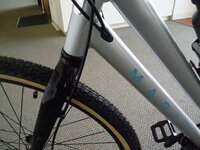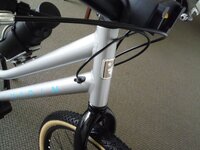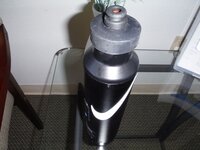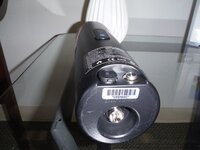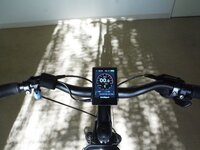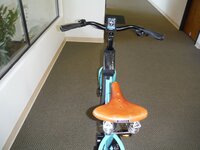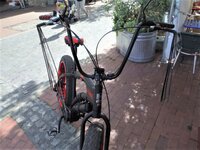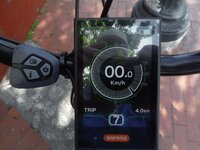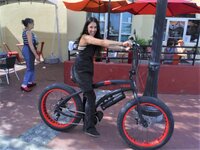You are using an out of date browser. It may not display this or other websites correctly.
You should upgrade or use an alternative browser.
You should upgrade or use an alternative browser.
How is purely torque-sensing PAS actually implemented?
- Thread starter Jeremy McCreary
- Start date
mschwett
Well-Known Member
- Region
- USA
until now the two types of e-bikes i've had have been mid drive, with torque sensing and lots of options for configuring power delivery, and front hub, with basically no options other than "help me go faster" and "don't help me go so much faster" 
for complicated reasons i'm thinking of picking up a lightweight rear hub drive bike, which has it's torque and cadence sensor in the bottom bracket, and find myself wondering if, given the same programming of the same available inputs (torque, cadence, speed), would it really feel exactly the same, basically? in some ways, the freewheel is just being moved from the rear cassette to the crank in a mid-drive, and under tension the link of the chain across the top of the cogs and ring is fairly direct.
the customization options for the latest integrated hub drives seem basically the same as higher end mid drives. i'm guessing that weight distribution is actually the biggest difference.
for complicated reasons i'm thinking of picking up a lightweight rear hub drive bike, which has it's torque and cadence sensor in the bottom bracket, and find myself wondering if, given the same programming of the same available inputs (torque, cadence, speed), would it really feel exactly the same, basically? in some ways, the freewheel is just being moved from the rear cassette to the crank in a mid-drive, and under tension the link of the chain across the top of the cogs and ring is fairly direct.
the customization options for the latest integrated hub drives seem basically the same as higher end mid drives. i'm guessing that weight distribution is actually the biggest difference.
PedalUma
Well-Known Member
- Region
- USA
- City
- Petaluma, CA
You really want the power to drive the chain, pulling it through the gears, so the motor's output can be shifted and is not single speed. In considering a wheel build with a hub, a mid-drive is also cost competitive/effective.
Bolas were used in the Americas from the Inuit to Patagonia. A type of flying gyro, they helped to make megafauna extinct, another ancient tech that wiped out megafauna was the atlatl. A small band could take down a mastodon.
Bolas were used in the Americas from the Inuit to Patagonia. A type of flying gyro, they helped to make megafauna extinct, another ancient tech that wiped out megafauna was the atlatl. A small band could take down a mastodon.
Jeremy McCreary
Bought it anyway
- Region
- USA
- City
- Carlsbad, CA
Those Wizzzers are tons of fun! For anyone unfamiliar, the tip connects to an internal metal flywheel free to spin relative to the lightweight outer plastic shell. You charge the flywheel with angular momentum by rolling the brownish "tire" on the side of the tip briskly across a table.We had Whizzers when we were kids in the 70's
View attachment 165636
I remember getting three stacked on top of each other.
Since that's all the angular momentum the whole assembly needs to stand against gravity, you can use the shell as a "handle" to manipulate the wizzzer in all kind of cool ways just not possible with a regular top — without killing the flywheel's spin. The shell also prolongs flywheel spin time by reducing its air resistance.
I've made LEGO wizzzers with some success, but a high-density metal flywheel is the key to the wizzzer's sky-high play value.
PCeBiker
No-Hands No-Pedaling No-Credentials
- Region
- Canada
You charge the flywheel with angular momentum by rolling the brownish "tire" on the side of the tip briskly across a table.
I wore my rubber "tire" until it was a flat V shape, and the bushing between the shell and the flywheel was all worn and sloppy.
I put a lot of miles on my first Whizzer.
is there a special controller that has inputs for the torque sensor available like on Aliexpress ?The TMM4 sensor does not have a cadence sensor, it is only a torque sensor.
But IDbike licenses their sensor technology to a number of bike manufacturers, who then make their own version of it.
Juiced bike is using their own modified version that adds a cadence sensor (which appears to be capable of measuring the cadence) using a magnet positioned close to the sprocket.
What they actually do with it would have to be asked to them
IDbike TMM4 sensor does not have the added cadence sensor shown below on a juiced version.
View attachment 159120
KylerLaird
New Member
- Region
- USA
I just noticed the post from mschwett. I've been building front-wheel hub motor bikes with BB torque sensors (T9 and now T17). I use dumb (VESC ADC) control - just the torque sensor. It is wonderful. If I crank up the power it is the kind of amazing that forces me to grin like a doofus.
I also have a trike that came with a front hub motor, a tiny controller, and a BB torque sensor. It doesn't work at all - total junk. Torque control can definitely be done well or poorly.
BTW, I don't use cadence. I want to push on the pedal and get power. On my bikes, I do. Zoom! I've wondered if the crappy trike requires some cadence before kicking in a bit of power. Useless.
I do gradually engage braking when the torque goes to zero. I love this but I've thought about disabling it if the (forward) cadence is non-zero. And increasing it with reverse cadence (on the T17).
I also have a trike that came with a front hub motor, a tiny controller, and a BB torque sensor. It doesn't work at all - total junk. Torque control can definitely be done well or poorly.
BTW, I don't use cadence. I want to push on the pedal and get power. On my bikes, I do. Zoom! I've wondered if the crappy trike requires some cadence before kicking in a bit of power. Useless.
I do gradually engage braking when the torque goes to zero. I love this but I've thought about disabling it if the (forward) cadence is non-zero. And increasing it with reverse cadence (on the T17).
PedalUma
Well-Known Member
- Region
- USA
- City
- Petaluma, CA
That is normal. So, you can be at an intersection with your foot resting on the pedal and not surge into traffic. With 24 magnets on the cadence wheel, that means 15 degrees of movement before power kicks in. On an analog 12-hour clock face that would be 2.5 minutes of movement. It is a safety thing.requires some cadence
Virtually every commercial torque sensing configuration also has some sort of pedal movement (cadence) sensing, whether it's a separate sensor or some sort of analysis of the waveforms from the torque sensor. As PU says "it is a safety thing". On the surface it just makes sense for the logic to check and see that the user is moving the pedals as well as wanting assist. But thinking about the use case that KylerLaird mentions I can see situations where immediate assist on pedal pressure can also be desirable. It's similar to the use of a throttle from a standing start ... something I really like and while it can be abused I think it actually increases safety, especially in and around traffic.
PedalUma
Well-Known Member
- Region
- USA
- City
- Petaluma, CA
2.5 minutes of movement is not much, almost immediate. I wouldn't want a bike leaping forward if I touched a pedal without intentional rotation. I do not use brake cutout levers. I did on my first couple of builds. It just added ugly wires and didn't do anything for me. But they could make sense on a throttle bike. I sometimes use power and brakes at the same time in technical maneuvers around roots and rocks were I can feather the brakes while using the pedals on a torque sensing mid-drive. It creates a positive tension.
PedalUma
Well-Known Member
- Region
- USA
- City
- Petaluma, CA
Here is one I made a couple of years ago. Check out the wires. I cheated buy running the battery wire inside the top tube and out the seat tube if you zoom you can see it low on the backside of the seat tube. That is the small display between the bell and left lever. I am rained in for another 1/2 hour. Then I can ride. The second bike, black, is a standard cadence BBS02 that I made a clean as I could. Check out the apps on the smart phone.

Attachments
PedalUma
Well-Known Member
- Region
- USA
- City
- Petaluma, CA
Look at the phone bag on the top tube of the black Trek with the Bafang mid-drive and this cargo bike with an HD motor. That is were I stuffed the extra wires and the connectors. In plain sight.eliminated the cable
Attachments
Ken Shopken
Active Member
- Region
- USA
Thank you... I was just asking about this very subject.You can buy a torque sensor from Grin ebikes at ebikes.ca. along with their Cycle Analyst display unit. The sensor installs in your bottom bracket and puts out a signal for your pedal pressure. The Cycle analyst converts that to a voltage that most hub motor controllers can recognize as a throttle voltage.
.
https://ebikes.ca/getting-started/pas-options.html
.
However, I am sure the ultimate systems would take into account how fast the pedals are spinnning, the speed of the wheel, and combine all of this into a more pleasureable pedaling experience. Not happening with the above,
.
I am fiddling with a middrive kit, made by Tong Sheng, that uses torque sensing. I didn't get it running til November, so cold weather has limited my trials. The system works, but I.m not sold on whether the added complexity is worth it,
Have you converted a hub motor to a torque sensor already?
I converted a mountain bike with the Tongshen kit.. I think the type of assist it offers is excellent compared to the cadence sensor.
PCeBiker
No-Hands No-Pedaling No-Credentials
- Region
- Canada
That is were I stuffed the extra wires and the connectors.
I didn't have enough room inside my down tube for the extra ~18" of cable.
I'd have to go back and forth a few times and I was worried about bending the cable at a really tight radius.
I could have coiled it up ouf of sight under the bottom bracket, but I thought that was a bad spot for it.
PedalUma
Well-Known Member
- Region
- USA
- City
- Petaluma, CA
Bafangs have long cables. On those two Bafang builds and others. I took a longer route to use up cable. Instead of the more direct down tube, I went up the seat tube and under the top tube. Here is another Bafang. Darn it is still raining.extra ~18" of cable
Attachments
PCeBiker
No-Hands No-Pedaling No-Credentials
- Region
- Canada
Bafangs have long cables.
They must be designed to fit 8 foot long cargo bikes?
The 1-5 cable is longer than the 1-4 cable too.
PedalUma
Well-Known Member
- Region
- USA
- City
- Petaluma, CA
A new law is going to come up in the California Legislature banning throttles for those 16 and younger. What it does not address is that most less expensive bikes on-line and at big box stores can be ghost pedaled. If you can pedal at a cadence in single digits and with no effort yet go full speed, it is just the same as a throttle! I most often cut and splice cables. Half of the little wires go one way and about half the other. Each gets soldered and sealed, then marine grade shrink tube slide downs and over the whole thing. It takes out the slack.
Similar threads
- Replies
- 15
- Views
- 5K
- Replies
- 11
- Views
- 2K
- Replies
- 1
- Views
- 3K
- Replies
- 0
- Views
- 3K

